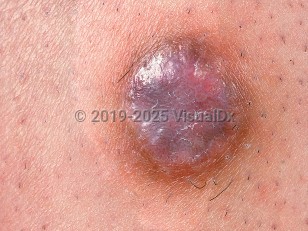Dermatofibroma in Child
Alerts and Notices
Important News & Links
Synopsis

Dermatofibromas (DFs), or histiocytomas, are common benign fibrohistiocytic tumors that tend to occur in a solitary fashion. Some individuals have several lesions but rarely have more than 15. DFs have a predilection for the lower extremities; however, in children younger than 10 years, the most common location of DFs is on the trunk. They are usually asymptomatic but may occasionally be pruritic or tender.
Twenty percent of DFs occur in children aged 17 years and younger. The etiology is not completely understood, but it is suspected that many DFs are initiated by injuries to the skin, such as by insect bites or blunt trauma.
Rarely, multiple eruptive dermatofibromas (MEDF) may be seen. MEDF is arbitrarily defined as the presence of 5 to 15 or more DFs developing in less than a 4-month period. MEDF has been reported to occur in individuals with HIV infection; autoimmune disease, most frequently systemic lupus erythematosus; neoplastic disease; and in pregnant individuals. Multiple clustered dermatofibroma (MCDF) is a rare entity that develops in the first to third decades, where 15 or more DFs cluster together to form a plaque, most often on the lower half of the body.
In rare families with dominantly inherited DF, missense mutation in the factor XIII A-subunit has been detected.
While classic DFs are the predominant type of DF observed in pediatric patients, similar histologic DF variants in pediatric patients to those in adults have been described. Some rare variants of DFs, in particular the atypical, cellular, and aneurysmal variants, have been reported to have increased risk of local recurrences when incompletely excised. The cellular variant is the most common variant in pediatric patients; they usually are larger in size than common DFs.
Although the overwhelming majority of DFs are benign, exceedingly rare reports of distant metastases have been reported from cellular, aneurysmal, and atypical DF subtypes in adults.
Twenty percent of DFs occur in children aged 17 years and younger. The etiology is not completely understood, but it is suspected that many DFs are initiated by injuries to the skin, such as by insect bites or blunt trauma.
Rarely, multiple eruptive dermatofibromas (MEDF) may be seen. MEDF is arbitrarily defined as the presence of 5 to 15 or more DFs developing in less than a 4-month period. MEDF has been reported to occur in individuals with HIV infection; autoimmune disease, most frequently systemic lupus erythematosus; neoplastic disease; and in pregnant individuals. Multiple clustered dermatofibroma (MCDF) is a rare entity that develops in the first to third decades, where 15 or more DFs cluster together to form a plaque, most often on the lower half of the body.
In rare families with dominantly inherited DF, missense mutation in the factor XIII A-subunit has been detected.
While classic DFs are the predominant type of DF observed in pediatric patients, similar histologic DF variants in pediatric patients to those in adults have been described. Some rare variants of DFs, in particular the atypical, cellular, and aneurysmal variants, have been reported to have increased risk of local recurrences when incompletely excised. The cellular variant is the most common variant in pediatric patients; they usually are larger in size than common DFs.
Although the overwhelming majority of DFs are benign, exceedingly rare reports of distant metastases have been reported from cellular, aneurysmal, and atypical DF subtypes in adults.
Codes
ICD10CM:
D23.9 – Other benign neoplasm of skin, unspecified
SNOMEDCT:
427186000 – Dermatofibroma
D23.9 – Other benign neoplasm of skin, unspecified
SNOMEDCT:
427186000 – Dermatofibroma
Look For
Subscription Required
Diagnostic Pearls
Subscription Required
Differential Diagnosis & Pitfalls

To perform a comparison, select diagnoses from the classic differential
Subscription Required
Best Tests
Subscription Required
Management Pearls
Subscription Required
Therapy
Subscription Required
References
Subscription Required
Last Reviewed:01/26/2022
Last Updated:02/15/2022
Last Updated:02/15/2022
 Patient Information for Dermatofibroma in Child
Patient Information for Dermatofibroma in Child
Premium Feature
VisualDx Patient Handouts
Available in the Elite package
- Improve treatment compliance
- Reduce after-hours questions
- Increase patient engagement and satisfaction
- Written in clear, easy-to-understand language. No confusing jargon.
- Available in English and Spanish
- Print out or email directly to your patient
Upgrade Today

Dermatofibroma in Child

